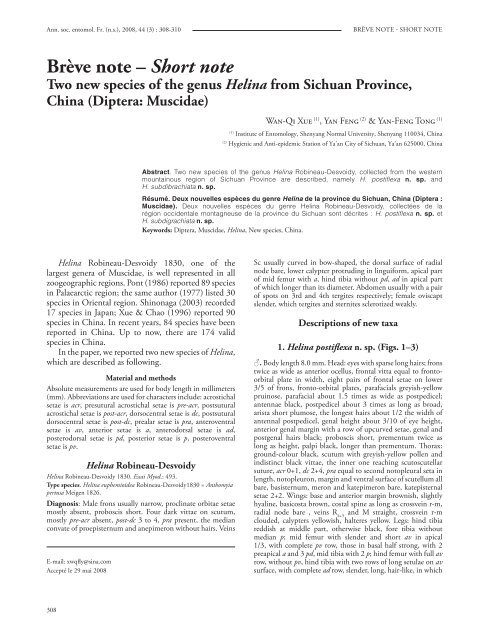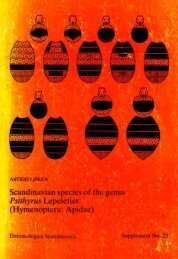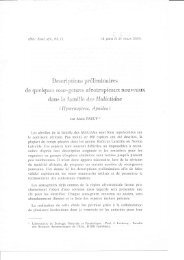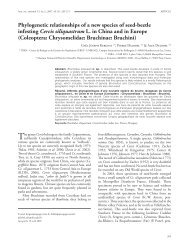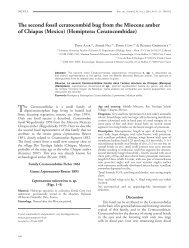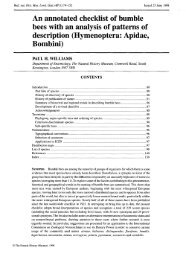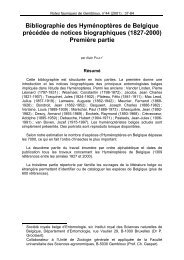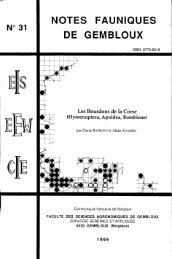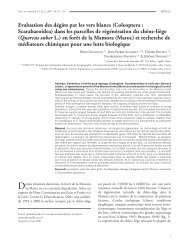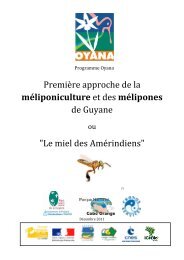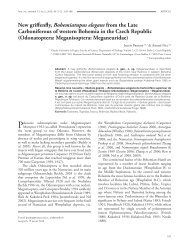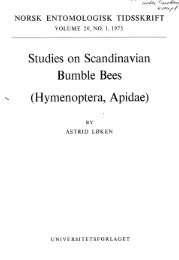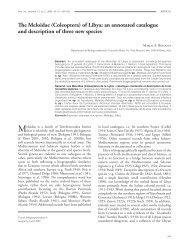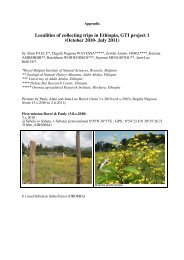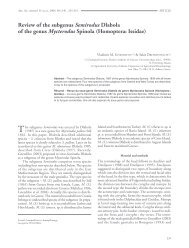ASEF 3-2008.indb - Laboratoire de Zoologie
ASEF 3-2008.indb - Laboratoire de Zoologie
ASEF 3-2008.indb - Laboratoire de Zoologie
You also want an ePaper? Increase the reach of your titles
YUMPU automatically turns print PDFs into web optimized ePapers that Google loves.
Ann. soc. entomol. Fr. (n.s.), 2008, 44 (3) : 308-310<br />
BRÈVE NOTE - SHORT ARTICLE NOTE<br />
Brève note – Short note<br />
Two new species of the genus Helina from Sichuan Province,<br />
China (Diptera: Muscidae)<br />
Wan-Qi Xue (1) , Yan Feng (2) & Yan-Feng Tong (1)<br />
(1)<br />
Institute of Entomology, Shenyang Normal University, Shenyang 110034, China<br />
(2)<br />
Hygienic and Anti-epi<strong>de</strong>mic Station of Ya’an City of Sichuan, Ya’an 625000, China<br />
Abstract. Two new species of the genus Helina Robineau-Desvoidy, collected from the western<br />
mountainous region of Sichuan Province are <strong>de</strong>scribed, namely H. postifl exa n. sp. and<br />
H. subdibrachiata n. sp.<br />
Résumé. Deux nouvelles espèces du genre Helina <strong>de</strong> la province du Sichuan, China (Diptera :<br />
Muscidae). Deux nouvelles espèces du genre Helina Robineau-Desvoidy, collectées <strong>de</strong> la<br />
région occi<strong>de</strong>ntale montagneuse <strong>de</strong> la province du Sichuan sont décrites : H. postifl exa n. sp. et<br />
H. subdigrachiata n. sp.<br />
Keywords: Diptera, Muscidae, Helina, New species, China.<br />
Helina Robineau-Desvoidy 1830, one of the<br />
largest genera of Muscidae, is well represented in all<br />
zoogeographic regions. Pont (1986) reported 89 species<br />
in Palaearctic region; the same author (1977) listed 30<br />
species in Oriental region. Shinonaga (2003) recor<strong>de</strong>d<br />
17 species in Japan; Xue & Chao (1996) reported 90<br />
species in China. In recent years, 84 species have been<br />
reported in China. Up to now, there are 174 valid<br />
species in China.<br />
In the paper, we reported two new species of Helina,<br />
which are <strong>de</strong>scribed as following.<br />
Material and methods<br />
Absolute measurements are used for body length in millimeters<br />
(mm). Abbreviations are used for characters inclu<strong>de</strong>: acrostichal<br />
setae is acr, presutural acrostichal setae is pre-acr, postsutural<br />
acrostichal setae is post-acr, dorsocentral setae is dc, postsutural<br />
dorsocentral setae is post-dc, prealar setae is pra, anteroventral<br />
setae is av, anterior setae is a, anterodorsal setae is ad,<br />
posterodorsal setae is pd, posterior setae is p, posteroventral<br />
setae is pv.<br />
Helina Robineau-Desvoidy<br />
Helina Robineau-Desvoidy 1830. Essai Myod.: 493.<br />
Type species. Helina euphemioi<strong>de</strong>a Robineau-Desvoidy1830 = Anthomyia<br />
pertusa Meigen 1826.<br />
Diagnosis: Male frons usually narrow, proclinate orbitae setae<br />
mostly absent, proboscis short. Four dark vittae on scutum,<br />
mostly pre-acr absent, post-dc 3 to 4, pra present, the median<br />
convate of proepisternum and anepimeron without hairs. Veins<br />
E-mail: xwqfly@sina.com<br />
Accepté le 29 mai 2008<br />
Sc usually curved in bow-shaped, the dorsal surface of radial<br />
no<strong>de</strong> bare, lower calypter protruding in linguiform, apical part<br />
of mid femur with a, hind tibia without pd, ad in apical part<br />
of which longer than its diameter. Abdomen usually with a pair<br />
of spots on 3rd and 4th tergites respectively; female oviscapt<br />
slen<strong>de</strong>r, which tergites and sternites sclerotized weakly.<br />
Descriptions of new taxa<br />
1. Helina postiflexa n. sp. (Figs. 1–3)<br />
♂. Body length 8.0 mm. Head: eyes with sparse long hairs; frons<br />
twice as wi<strong>de</strong> as anterior ocellus, frontal vitta equal to frontoorbital<br />
plate in width, eight pairs of frontal setae on lower<br />
3/5 of frons, fronto-orbital plates, parafacials greyish-yellow<br />
pruinose, parafacial about 1.5 times as wi<strong>de</strong> as postpedicel;<br />
antennae black, postpedicel about 3 times as long as broad,<br />
arista short plumose, the longest hairs about 1/2 the width of<br />
antennal postpedicel, genal height about 3/10 of eye height,<br />
anterior genal margin with a row of upcurved setae, genal and<br />
postgenal hairs black; proboscis short, prementum twice as<br />
long as height, palpi black, longer than prementum. Thorax:<br />
ground-colour black, scutum with greyish-yellow pollen and<br />
indistinct black vittae, the inner one reaching scutoscutellar<br />
suture, acr 0+1, dc 2+4, pra equal to second notopleural seta in<br />
length, notopleuron, margin and ventral surface of scutellum all<br />
bare, basisternum, meron and katepimeron bare, katepisternal<br />
setae 2+2. Wings: base and anterior margin brownish, slightly<br />
hyaline, basicosta brown, costal spine as long as crossvein r-m,<br />
radial no<strong>de</strong> bare , veins R 4+5<br />
and M straight, crossvein r-m<br />
clou<strong>de</strong>d, calypters yellowish, halteres yellow. Legs: hind tibia<br />
reddish at middle part, otherwise black, fore tibia without<br />
median p; mid femur with slen<strong>de</strong>r and short av in apical<br />
1/3, with complete pv row, those in basal half strong, with 2<br />
preapical a and 3 pd, mid tibia with 2 p; hind femur with full av<br />
row, without pv, hind tibia with two rows of long setulae on av<br />
surface, with complete ad row, slen<strong>de</strong>r, long, hair-like, in which<br />
308
New species of the genus Helina<br />
2-3 are strong, with a complete series of slen<strong>de</strong>r hairs on pv<br />
surface, gradually becoming longer basad. Abdomen: groundcolour<br />
black, cone-shaped, with dark grey pruinose, tergites 3<br />
and 4 each with a pair of large ellipse-shaped brown marks;<br />
sternite 1 bare.<br />
♀. Unknown.<br />
Holotype. male, China, Sichuan Province: Forest Farm of<br />
Er’lang Hills (29°58‘N 102°20‘E), 2680 m, 20. VIII. 1984, Coll.<br />
Y. Feng. Paratype. China, 1 male, same data as holotype. The<br />
holotype is <strong>de</strong>posited in the Medical Entomological Collection,<br />
Institute of Microbiology and Epi<strong>de</strong>miology, Beijing.<br />
This new species will key to couplet 153 (154) in<br />
Hennig (1957), but it differs distinctly from H. veterana<br />
Zetterstedt and can be incorporated into Hennig’s key<br />
as follows:<br />
153 (154) ...................................... Hind tibia wholly straight<br />
153a (153b) Eyes covered with <strong>de</strong>nse long hairs; inner<br />
margin of fronto-orbital plates, lunule and parafacials<br />
with silvery white pruinose; scutum with four distinct<br />
longitudinal vittae; abdomen with even greyish-yellow<br />
pruinose ........................................H. veterana Zetterstedt<br />
Figures 1–6<br />
Helina postiflexa n. sp. (♂). 1, 5th sternite in ventral view; 2, cerci in<br />
posterior view; 3, terminalia in lateral view. Helina subdibrachiata n. sp.<br />
(♂). 4, 5th sternite in ventral view; 5, cerci in posterior view; 6, terminalia<br />
in lateral view.<br />
153b (153a) Eyes with sparse long hairs, fronto-orbital<br />
plates and parafacials greyish-yellow pruinose, scutum<br />
with indistinct black vittae, abdomen with dark grey<br />
pruinose, the inner apical lobe of cerci mo<strong>de</strong>rately<br />
broa<strong>de</strong>r and shorter, the outer one protruding only<br />
slightly ................................................ H. postifl exa n. sp.<br />
The new species also resembles H. subhirsutitibia<br />
Wu, but it differs from the latter by having eyes with<br />
sparse long hairs; mid femur with slen<strong>de</strong>r and short<br />
av in apical 1/3; hind tibia with a complete ad row;<br />
abdomen dark grey pruinose; male cerci becoming<br />
narrow in distal half in profile (becoming broad in H.<br />
subhirsutitibia), inner lobes of cerci mo<strong>de</strong>rately closer<br />
to each other in posterior view (slightly separated in H.<br />
subhirsutitibia).<br />
2. Helina subdibrachiata n. sp. (Figs. 4–6)<br />
♂. Body length 5.0 mm. Head: eyes bare; frons about 1.5 times<br />
as wi<strong>de</strong> as anterior ocellus, frontal vitta slightly broa<strong>de</strong>r than<br />
1/2 the width of fronto-orbital plate, seven pairs of frontal<br />
setae on lower half of frons, fronto-orbital plates and parafacials<br />
silvery grey pruinose, parafacial as wi<strong>de</strong> as antennal postpedicel;<br />
antennae black, postpedicel about 3 times as long as broad,<br />
arista long plumose, the longest hairs about 1.5 times the width<br />
of antennal postpedicel; genal height about 1/5 of eyes height,<br />
genal and postgenal hairs all black; proboscis short, prementum<br />
1.5 times as long as height, palpi black, longer than prementum.<br />
Thorax: ground-colour black, scutum with grey pruinose and<br />
four black vittae, the inner two not reaching to scutoscutellar<br />
suture, acr 0+1, dc 2+4, pra about 1/3 the length of second<br />
notopleural seta, notopleuron, margin and ventral surface of<br />
scutellum bare, basisternum, meron and katepimeron bare,<br />
katepisternal setae 2+2. Wings translucent, tegula and basicosta<br />
black-brown, costal spine slightly shorter than crossvein r-m,<br />
radial no<strong>de</strong> bare, veins R 4+5<br />
and M straight, calypters yellowish,<br />
halteres yellow. Legs: knees brownish-yellow, tibiae brown,<br />
otherwise all black, fore tibia without median p; mid femur<br />
with 3 pv in basal, mid tibia with 2 p; hind femur with a row<br />
of long av, those in basal half sparse, without pv, hind tibia<br />
with 3 av, 4 ad and 1 prebasal pd, with a series of posterior<br />
setulae on middle. Abdomen: dark brown, cone-shaped, with<br />
grey pruinose, tergites 3 and 4 each with a pair of black brown<br />
marks and central pruinose vitta; sternite 1 bare.<br />
♀. Unknown.<br />
Holotype. male, China, Sichuan Province, Maowen,<br />
Cibusuyabazai (30°06′ N, 103°09′ E), 2300 m, 22. VIII. 1983.<br />
X. R. Qiao. Paratype, China, 1 male, same data as holotype. The<br />
holotype is <strong>de</strong>posited in the Medical Entomological Collection,<br />
Institute of Microbiology and Epi<strong>de</strong>miology, Beijing.<br />
In Hennig (1957), H. subdibrachiata n. sp. will<br />
key through the genus Helina (♂♂) to couplet 168<br />
(169). H. subdibrachiata n. sp. can be incorporated<br />
into Hennig’s (1957) male key as follows:<br />
168 (169) Hind femur without pv setae, sternites without<br />
long hairs<br />
168a (168b) Frons about 3 times width of<br />
anterior ocellus, the longest aristal hairs<br />
about as long as the width of postpedicel, and<br />
cerci without lateral lobe ......................H. reversio (Harris)<br />
309
W.-Q. Xue, Y. Feng & Y.-F. Tong<br />
168b (168a) Frons about 1.5 times width of anterior<br />
ocellus, the longest aristal hairs about 1.5 times as long<br />
as the width of postpedicel, and cerci <strong>de</strong>eply furcated<br />
laterally ...................................... H. subdibrachiata n. sp.<br />
It also resembles H. dibrachiata Fang, Li &<br />
Deng, but the pra is about 1/3 the length of second<br />
notopleural setae; hind tibia with a row of setulae on<br />
posterior surface; male cerci <strong>de</strong>eply furcated laterally,<br />
the point of the fork almost reaching to basal 1/3 of<br />
cerci, surstyli mo<strong>de</strong>rately short.<br />
Acknowledgements. The authors are very grateful to Dr.<br />
Adrian C. Pont (University Museum of Natural History,<br />
Oxford, U.K.) who read this paper and give much helpful<br />
advice; and the National Natural Science Foundation of<br />
China (Project No.30870330) and the Experimental central<br />
director’s Foundation of Shenyang Normal University (Project<br />
No.SY200609) for funding this project.<br />
References<br />
Fan Z. D. 1992. Key to the common fl ies of China, 2nd ed. Science Press,<br />
Beijing, p. 210-456. [In Chinese with English Summary]<br />
Fang J. M., Li R., Deng A. X. 1986. New records of Phaoniinae from<br />
western region of China (I). Collected Papers of Entomological Research<br />
6:237-245. [In Chinese]<br />
Feng Y. 2000. Eight new species of the Muscidae from Sichuan, China<br />
(Diptera: Muscidae). Sichuan Journal of Zoology 19(1):3-7. [In<br />
Chinese]<br />
Hennig W. 1955-1964. 63b. Muscidae, p. 149-154. in: Lindner E. (ed.),<br />
Die Fliegen <strong>de</strong>r palaearktischen Region, Band VII 2<br />
, E. Schweizerbart’sche<br />
Verlagsbuchhandlung, Stuttgart, 1100 p.<br />
Ma Z. Y. 1981. Five new species of the Family Muscidae from Liaoning<br />
Province (Diptera). Acta Zootaxonomia Sinica 6(3):300-307. [In<br />
Chinese]<br />
Pont A. C. 1977. Muscidae, p. 477-479. in: Delfinado M. D., Hardy<br />
D.E. (eds.), A Catalog of Diptera of the Oriental Region, Volume 3,<br />
University Press of Hawaii, Honolulu, 763 p.<br />
Pont A. C. 1986. Scathophagidae-Hypo<strong>de</strong>rmatidae, p. 135-153. in:<br />
Soós Á., Papp L. (eds.), Catalogue of Palaearctic Diptera, Volume 11,<br />
Akadémiai Kiadó, Budapest, 1 map + 346 p.<br />
Satoshi Shinonaga. 2003. A Monograph of the Muscidae of Japan. Tokai<br />
University Press, Tokyo, p. 179-198.<br />
Wu J. W. 1989. Five new species of the genus Helina from Gansu Province.<br />
Entomotaxonomia 11(4):323-332. [In Chinese]<br />
Xue W. Q. 1998. Muscidae, p. 836-845, 1116-1165. in: Xue W. Q.,<br />
Chao C. M. (eds.), Flies of China, Volume 1, Liaoning Science and<br />
Technology Press, Shengyang, 1 map + 2425 p. [In Chinese]<br />
Xue W. Q., Wang M. F., Tong Y. F. 2003. Four new species of the genus<br />
Helina R.-D. from Qinghai, China (Diptera: Muscidae). Acta<br />
Zootaxonomia Sinica 28(4):754-757. [In Chinese]<br />
310


